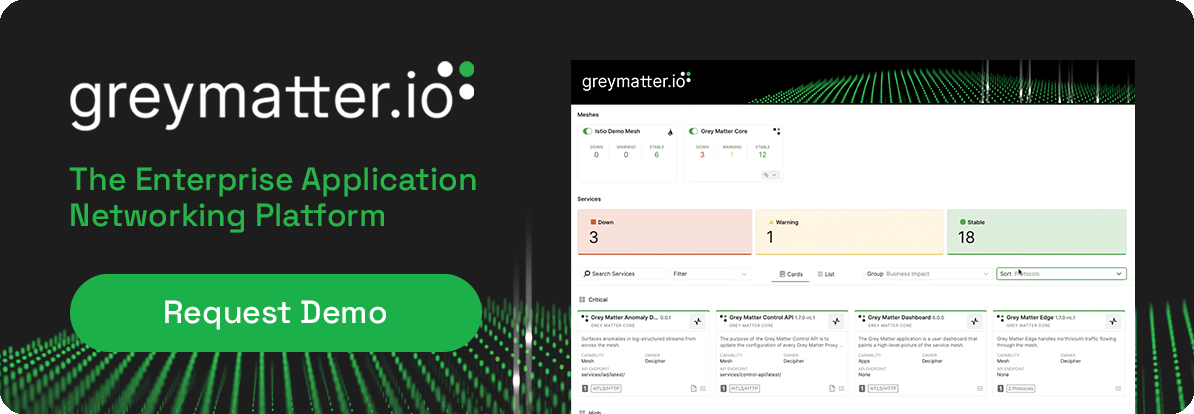blog
Application Networking Platform: What the Hyper-Dynamic Enterprise Needs Now
Revolutionize your enterprise with the Application Networking Platform designed for the hyper-dynamic future.

October 3, 2023
How enterprises build, deploy, and monitor applications has changed dramatically over the past several years. To accelerate software delivery, we’ve moved from a monolith architecture consisting of several applications running on servers in an on-premises data center to a cloud-native approach.
Piloting cloud-native
As teams started to pilot projects using microservices, containers, API-based communications, and agile software development, the advantages in application delivery speed were undeniable. But they soon hit roadblocks. Separate programming language tools, development frameworks, and logging tools introduced complexity. Each microservice in a cloud-native environment is a separate application unto itself with limited control, security, and visibility. As services moved from production to deployment, IT teams often became frustrated by their limited capability to understand, control, and see what was happening in applications they were responsible for managing across hybrid and multi-cloud environments.
53% say complex implementations for multi-cloud/hybrid are a significant challenge.1
Kickstarting the journey to distributed applications at scale
Service meshes are intended to address these challenges. And they have – to a degree. For static, small-scale, Kubernetes environments, service meshes provide a de-coupled layer away from the application code. They are designed to control configuration policies, route internal east-west application traffic, and enforce security across connected microservices, APIs, and data sources. However, as the volume of services increases, distributed applications often fail architectural review for reasons including configuration errors, security flaws, and lack of multi-cloud support.
More than half of security, DevOps, & dev professionals cite API security concerns for delayed rollout of a new service or app. 2
Service mesh is an entry point, but it has been over-hyped. On its own, it cannot address the complex software development, delivery, and governance requirements of enterprise architectures across on-prem, container, hybrid, and multi-cloud environments while ensuring zero-trust application security.
99% of cloud-native environments have over-privileged IDs.3
Organizations continuing their journey to accelerate software delivery, while ensuring security need more.
Empowering the hyper-dynamic enterprise
In an era of exponentially greater complexity, where multi-cloud is mainstream and organizations in highly regulated industries continue to maintain critical assets and data on-prem as well, teams need an alternative to fragmented tools and open-source solutions.
This is where an end-to-end, enterprise-grade application networking platform like Greymatter comes in. It’s completely platform-agnostic and container-agnostic to meet you where you are and serve as a bridge to the future.
As the number of APIs, apps, and microservices increase, and your control, security, and visibility decrease, it tackles software delivery complexity and risk. It succeeds where cloud provider-specific solutions simply cannot – across multi-cloud and hybrid environments. And although it builds on a service mesh as do first-generation platforms, it goes well beyond with less complexity. The platform delivers critical service connectivity layer (SCL) functionality, enabling developers to focus on building great software without the need to interface directly with network plumbing or security controls, directly in-line with the tenets of platform engineering.
With a head start working with the largest defense and intelligence agencies, Greymatter has built the most proven and comprehensive, modern application networking platform.

Fig 1. The Enterprise Integration Lifecycle
Designed to simplify control, security, and visibility across today’s multi-tenant and hyper-dynamic environments, it centralizes configuration management, ensures an identity-aware networking environment, provides comprehensive audit capabilities with threat intelligence integration, and offers a consolidated dashboard for a comprehensive view of operations. The result? It delivers on the promise of microservices architectures for greater application agility, flexibility, and scalability, by:
- Enabling rapid, reliable, and repeatable delivery of new software,
- Delivering cybersecurity mesh architecture for zero-trust security,
- Integrating with existing IT investments, and
- Enabling smarter business decision-making across the enterprise.
Wherever you are on your journey, contact us to schedule your free consultation. We’ll start by helping you determine your microservices maturity level. Then we’ll build a reference implementation architecture to begin advancing your journey to accelerate software delivery and increase speed to market while ensuring great control, security, and visibility with minimal configuration or code.
Further reading:
The Greymatter.io Microservices Maturity Model
Putting Service Mesh in Its Place
Sources:
1 Software AG Survey, February and March 2022; 1,150 respondents to Survey
2 API Security: Latest Insights and Key Trends, Google Cloud 2022 Research Report
3 2022 IBM Security X-Force Cloud Threat Landscape Report

